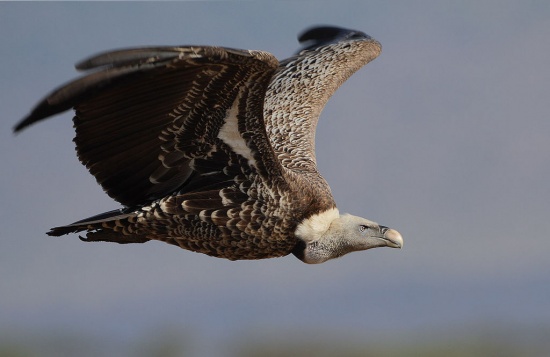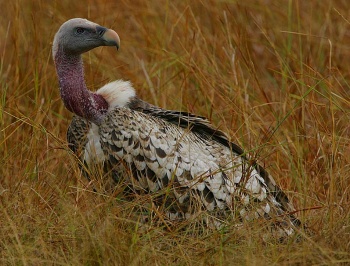Alternative names: Rueppell's Griffon Vulture, Rueppell's Vulture, Rüppells Griffon
- Gyps rueppelli
Gyps rüpellii, Gyps rueppellii
Identification
101 cm (39¾ in)
Adult Sexes are alike
- Mottled brown or black overall
- Whitish-brown underparts
- Thin, dirty-white fluff covering the head and neck
- White collar
- Yellow or amber eye
- Chocolate-brown crop patch
Juvenile: dark body and streaked, underwing relatively uniform with little contrast between flight feathers and coverts.
Flight
In flight as seen from below, notice the white line behind the front edge of the arm.
Similar species
Eurasian Griffon is about 10% larger and with slightly wider wings. Cape Griffon is larger and White-backed Vulture smaller. Juveniles would be very difficult to separate from juv Cape Vulture.
Distribution
Sub-Saharan Africa: occurs from southern Mauritania and Senegal east across Africa to Ethiopia and western Somalia and south to eastern Zaire, Uganda, west Kenya and northern Tanzania.
Formerly very common over most of range, but, like all African vultures, now listed as Critically Endangered, due to a combination of habitat loss and illegal poisoning by poachers. Resident but some dispersal, possibly of immatures.
Reported several times in southern Egypt but few recent records, also recorded within the Western Palearctic in northern Mauritania. However, there have been recent records from southern Spain and Portugal including three birds in August-December 1987, and several reports of small groups in the 1990s and 2000-1. The origins of these birds are unknown but presumably they return from Africa with migrant Griffons. In 1998 a bird was seen, apparently nesting, in a Griffon Vulture colony in Spain. In October 2001 one was recorded at Cape St Vincent in Portugal. A bird caught and released in Drome, France in 2003 was thought to be an escape.
Taxonomy
Subspecies
Two races are recognised[1]:
- G. r. rueppelli:
- South West Mauritania to eastern Sudan, Uganda, Kenya and Tanzania
- G. r. erlangeri:
Habitat
Arid and mountainous areas, particularly semi-desert and the fringes of deserts. They occur at heights up to 4500 m in Ethiopia.
Behaviour
They roost, feed and fly communally. Known to fly higher than any other bird, with one colliding with an aeroplane at 11,300 metres altitude over Abijan, Ivory Coast.
Diet
They feed on large animal carcasses, eating small bones, soft muscle and organs.
References
- Clements, J. F., T. S. Schulenberg, M. J. Iliff, D. Roberson, T. A. Fredericks, B. L. Sullivan, and C. L. Wood. 2016. The eBird/Clements checklist of birds of the world: v2016, with updates to August 2016. Downloaded from http://www.birds.cornell.edu/clementschecklist/download/
- Birdforum thread discussing id of this bird in European context
- Handbook of the Birds of the World Alive (retrieved June 2017)
Recommended Citation
- BirdForum Opus contributors. (2024) Rüppell's Vulture. In: BirdForum, the forum for wild birds and birding. Retrieved 6 October 2024 from https://www.birdforum.net/opus/R%C3%BCppell%27s_Vulture






